Long before the Altair was a gleam in Ed Roberts eye, Intel was quietly producing one of first microcomputers, and in fact, the first complete useable microcomputer, the Intel Intellec. The Intellec was developed by Intel for industry to help in the prototyping of computer systems using their microprocessors. The Intellec contains front panel programming, paper-tape or teletypewriter I/O, 16 slots, PL/M compiler, 16K RAM for a price of $2395. Intel did not sell alot of these computers as they didn't know what they had and did very little marketing, as such, few were made.
The Intellec-8 was used by Ed Roberts to help develop the Altair, and if you look closely at the front panel (and at the whole computer) you will noticed many similarities. The Altair front panel has just about all the data/address/control functions and LED's as the Intellec. Arrange in almost the same way. (The Altair used toggle switches instead of the push button switches on the Intellec). The Altair has the same type of motherboard, oriented in the same position as the Intellec. The Altair is slightly larger then the Intellec, due mostly by the slightly larger boards.
The Intellec is a much more robust system, however, more solidly made and reliable. Of course, the Intellec did cost about 5 times the price of the Altair. A nifty hinged hood makes for easy access of the internal boards.
As a part time programming consultant for Intel in 1972, Gary Kildall received an Intel Intellec-8 as partial payment for his services. Fascinated by computers, Gary created the first microcomputer language, PL/M on the Intellec in 1972, when Basic was just a gleam in Bill Gates eyes. PL/M was a simplified version of the mainframe language, PL/I, but significantly more sophisticated then the first BASIC introduced with the Altair.
Later, Gary realized that a cheap storage medium would be essential to making the personal computer practical. So he wrote another program, using the Intellec 8, that interfaced directly with the new floppy disk drives being produced at that time, he called this program CP/M (1974). Shortly afterwards he started his new company, Digital Research. CP/M became the standard programming language for personal computers until IBM announced their PC in 1983.
Documentation includes
The Intellec, showed in pictures, has the following boards
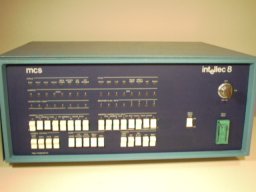 |
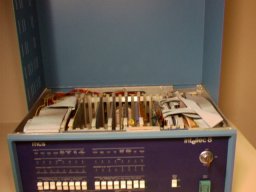 |
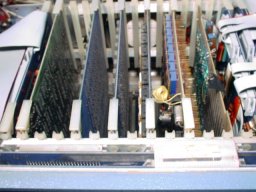 |
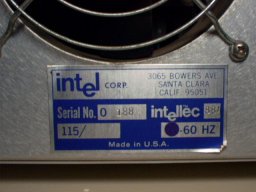 |
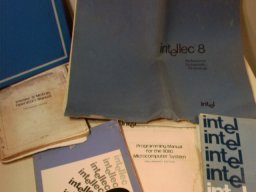 |
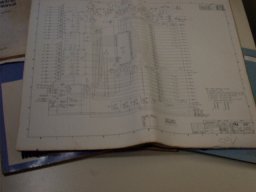 |
At US$2,395, the Intellec 8 was substantially more expensive than a later Altair 8800 or other 8080-based kit computer, but delivered solid value for money. Twenty years after it was built, Layer's 8 Mod 8 looks as if it could still boot and run for another century.
Its dimensions of 7"x17"x14" (18x44x36 cm) make it slightly smaller and taller than a modern AT-class desktop box, and at 30 lb (13.6 kg) it might be a bit heavier. It has a _very_ real front panel, tastefully silkscreened in white on navy blue, with three banks of sixteen red LED's:
Bank 1: STATUS: cpu RUNning, cpu WAITing, cpu HALTed, console access
HOLDing, cpu address SEARCH COMPLete, console ACCESS
REQuested, console INTerrupt REQuested, INT DISABLE [not used on the Mod 8].
CYCLE: FETCH instruction, cpu MEMory read/write, cpu I/O read/write, DmA, READ/INPUT, WRITE/OUTPUT, INTerrupt cycle, STACK [not used on the Mod 8].
Bank 2:
ADDRESS access: [15 and 14 not used on the Mod 8,] 13-0 display memory during access.
Bank 3:
INSTRUCTION / DATA: 7-0 display instruction or data between cpu and memory or input/output.
REGISTER/FLAG DATA: 7-0 display contents of cpu data bus or register on execution.
above two rows of white rocker switches:
Row 1:
ADDRESS / DATA: MEMory ADDRESS HIGHer bits for dma, I/O ADDRESS for manual access, SENSE DATA input.
ADDRESS / INSTRUCTION / DATA: MEMory ADDRESS LOWer bits for dma, INTerrupt INSTruction for fetch, DATA deposit to memory or input/output, data for load to PASS COUNT register.
Row 2:
ADDRESS CONTROL: LOAD PASS count to register, DECRement loaded address by one, INCRement loaded address by one, LOAD high and low address to register for dma.
MODE: cpu input SENSE data, I/O ACCESS for edit at cpu wait mode, MEMory ACCESS for edit at cpu wait mode, execute to SEARCH point and WAIT, enter manual WAIT state. (Tony Duell's comment on SEARCH/WAIT: "Very nice feature....You could set a trap on a particular location, and also set a counter. Then, the CPU would be forced into a wait state on the nth access to that location. Great for single-stepping the exit condition of large loops.")
CONTROL: single STEP through program or CONTinue from search complete, DEPosit 8-bit word during access, DEPosit 8-bit word AT programmed HaLT, cpu fetch/execute manual INTerrupt, RESET program counter to zero.
[Switches listed as "not used on the Mod 8" were enabled on the Mod 80 only.]
To the right of these controls and indicators is a combination keylock/power switch, and a PROM socket! with a power switch of its own....no need to pull the case and card when blowing or reading a fresh EPROM on an Intellec. Oh, and it's a ZIF socket, nothing new under the sun.
But let's pull the case anyway....woops....it doesn't pull, it's a flip-up case with a piano hinge at the back -- something that all too many micro owners might prefer even today. Underneath the case, the sides of the card cage are hinged too, then securely fastened to the frame. Access to components is excellent by any standard, certainly by comparison to modern nanotower cases and postcard motherboards.
An early clue to component quality is the startling size of the power-supply capacitor, as big as a small fist. The power supply is so conservatively rated that, when Layer bought the computer, the seller advised him to salvage the supply and junk the rest! Other low-stress components include a giant muffin fan in the backplate, and the cage itself, made out of aluminum bar stock.
The passive mainboard's sixteen slots run front-to-back and the slot guides are yet more satin-finish aluminum. Each modular card plugs into a full-length hundred-pin connector (identical to S-100, although the connections aren't,) and is supported by nylon card guides at both ends; the card guides are riveted to the crossbars of the cage. Fliplocks at the top corners of each card protect against creep and vibration, although I suspect that only a trip through a paint shaker would loosen a card accidentally.
Seven standard card modules were supplied with the 8 Mod 8:
imm8-82 Central processor module with 8008 CPU, memory and I/O interface, interrupt logic and crystal clock
imm6-28 (x2) 4K RAM module: 32x1Kbit 2102 static RAM chips
imm6-26 2K PROM module: 8x2Kbit 1702A static EPROM chips, eight empty sockets
imm8-60 I/O module: four 8-bit inputs, four 8-bit outputs, a UART, and serial TTY connectors
imm6-76 PROM Programmer module cabled to the 24-pin EPROM socket on the front panel
and the control module for the front panel. Nine slots were left empty. The stock machine was delivered with 8K static RAM and the Mod 8 system monitor (with paper tape support) burned into the 2K PROM; by combining and swapping other cards and chips, any combination of RAMs, ROMs or PROMs could be installed, up to the 16K addressable by the 8008. Unusually, RAM and ROM boards could be installed globally set to the same addresses, and their individual chips then enabled or disabled with jumpers.
[Available accessory cards included an Output module with eight 8-bit ports (8-62,) a breadboard for wire-wrap sockets (6-70,) and the 6-72 "pop-up" card with extended connectors to raise any module clear of the card cage.]
The backplate carries out the theme of sturdy construction. On each side of the fan mount, a subordinate cage provides five sockets for DB37 connectors. Hefty 3-wire power and a current loop interface through a Jones plug cater to the anticipated Teletype connection.
|
NO Copyright © 1998-2017
The material (manuals, brochures, etc.) is NOT to be used for any purpose other than private study, scholarship, or research. |
||
|
|
||
|
For any
problem contact the
. All logos and trademarks in this site are property of their respective owner.
|
||